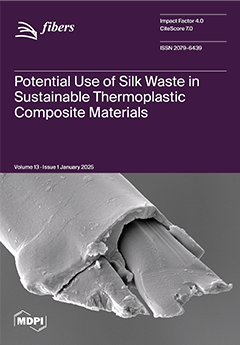The objective of this research was to evaluate the effect of dye obtained from
Buddleja coriacea and metallic mordants on the chromatic properties, textile characteristics, spectral profiles, and color stability in alpaca fibers. The dye extraction technique involved boiling in an aqueous solution,
[...] Read more.
The objective of this research was to evaluate the effect of dye obtained from
Buddleja coriacea and metallic mordants on the chromatic properties, textile characteristics, spectral profiles, and color stability in alpaca fibers. The dye extraction technique involved boiling in an aqueous solution, followed by filtration. Subsequently, alpaca yarns were dyed using the resulting extract following a standard protocol. The applied mordants included sodium sulfate (Na
2SO
4), aluminum sulfate and potassium dodecahydrate (KAl(SO
4)
2·12H
2O), and oxalic acid (C
2H
2O
4). Spectroscopy UV-Vis and FTIR spectrophotometry methods were used for the characterization of the dyed samples and analysis of the dye during the dyeing process. The findings revealed the formation of four distinct color tones. Additionally, it was determined that the mordants influenced the chromatic properties of the fibers dyed with
Buddleja coriacea extract without modifying their textile characteristics. The identified spectral bands corresponded to keratin, the structural protein of the fibers. Changes in the intensity of these spectral bands were observed in the dyed samples, attributable to the presence of different mordants. Wet rub fastness was found to be inferior to dry rub fastness, which has implications for textile maintenance. In conclusion,
Buddleja coriacea flowers provide an effective yellow dye, and when combined with various mordants, they allow for a variety of shades and hues in alpaca fiber yarns.
Full article





